Inside The New York Botanical Garden
Plant Talk
Posted in Gardens and Collections on April 2 2009, by Plant Talk
 |
Jessica Blohm is Interpretive Specialist for Public Education. |

Peter Kukielski, Curator of the Peggy Rockefeller Rose Garden, stakes and prunes this tree-form shrub rose named Rosa Home Run™. Spring is the time Peter cuts back the dead wood to promote flower production. This rose begins producing beautiful red roses in June and continues to bloom all summer long.


Gardeners Ken Molinari, top, and Jonathan Riggers prepare the beds for planting David Austin roses in a new English border—just one of many new additions to the Rose Garden this year in an effort to make the collection more disease-resistant.
Posted in People, Science on April 1 2009, by Plant Talk
Where Plants Live Forever
 |
Amanda Gordon is a freelance writer based in New York City. |
 The displays in The Orchid Show: Brazilian Modern include specimens of orchids and other plants from Brazil that are stored in the Botanical Garden’s William and Lynda Steere Herbarium. The fourth largest herbarium in the world and the largest in the Western Hemisphere, it contains more than 7 million specimens of plants and fungi.
The displays in The Orchid Show: Brazilian Modern include specimens of orchids and other plants from Brazil that are stored in the Botanical Garden’s William and Lynda Steere Herbarium. The fourth largest herbarium in the world and the largest in the Western Hemisphere, it contains more than 7 million specimens of plants and fungi.
So how does the Herbarium work, and how do scientists use it? To find out, I sat down with Dr. Barbara Thiers, Director of the Steere Herbarium and the C.V. Starr Virtual Herbarium. A plant scientist specializing in liverworts, Barbara belongs to a botanical family: Her father was a botanist who ran a herbarium, and her husband, Dr. Roy Halling, is also a scientist at the Garden, focusing on mushrooms.
What is the history of herbariums?
The concept of the herbarium originated in 14th- or 15th-century Italy. Plants were collected because people figured out early on that plants could be useful in treating maladies. Reference collections were made so people would know what plant to use for what. At first the plants were kept in bundles. Then someone got the idea of pressing the plants and putting them in books. The plants are then mounted on paper. That’s how specimens are preserved to this day.
Where are the specimens stored?
It’s amazing the amount of design that goes into making a good herbarium cabinet. The specimens are kept in specially designed steel cases with good sealing gaskets that keep them flat and dry and dark and away from bugs. If they’re well maintained, they can last indefinitely.
How do scientists use the specimens in the Steere Herbarium?
There’s a lot of use by people who are documenting rare and endangered species. Others are using the data for ecological modeling so they can ask questions about how the vegetation will change and how fast temperatures will rise in order to identify areas that are endangered or that are critical habitats for animals. A user could be curious about particular groups of plants—for example, forest species that are used for timber.
We have a number of herbarium sheets that are the “first-known collections” of specimens, such as purple loosestrife and cheat grass. The sheets can help to date the invasion of a species and to understand how a plant may have moved across a country. Government agencies are also heavy users—for example, the folks at Kennedy Airport. When they confiscate plant material, they’re supposed to do the best job they can to identify the material.
Do these records become obsolete?
No. Just the opposite: The specimen in the herbarium is how you save it forever after. Even when you have a very high-resolution digital image, there are some things you can only examine by looking at the actual specimen. This is the best information on what plants grew where and when.
You’ve already digitized 1.7 million specimens since 1995. What are your objectives for online access?
We have to do our best to handle all the material and make it as available for scientific research as possible. Our goal is to digitize the whole Steere Herbarium and to constantly improve the way we do it. Electronically, we’ll take some big leaps in how we share our data online. Wherever possible, we are linking the information about the specimens to the research that’s been done here by our staff and to the library collections. We’re creating a portal to the research that’s been done here.
How much use does the Steere Herbarium get?
People who come here to look at the specimens total 1,200 days spent here each year. We also send out 40,000 to 50,000 specimens a year for people to borrow. We send and receive 350 specimens a day in our shipping office.
Can amateur botanists use the Steere Herbarium or the Starr Virtual Herbarium?
We don’t have a lot of content that interprets what we have for a general audience, but we have some evidence that general audiences use it. We get a lot of hits by state and educational Web sites. We have dried specimens, so someone has to be able to look at a dried plant and imagine what it looks like. To look up a specimen you have to know the scientific name.
Do you get a chance to enjoy the living collections at the Botanical Garden?
I really love the Rock Garden, and one of my favorite places is Azalea Way. I like them not because they’re beautiful to look at, which they are, but because I have a great fondness for the plants that grow in those spots.
Please help support the important botanical research, education, and programs that are integral to the mission of The New York Botanical Garden.
Posted in Wildlife on March 31 2009, by Plant Talk
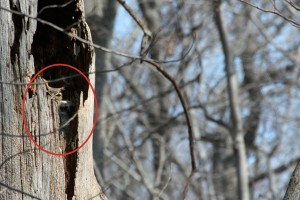
Click photo to enlarge.
Photo by Debbie Becker
Posted in Exhibitions, Learning Experiences, The Orchid Show on March 31 2009, by Plant Talk
 |
Jessica Blohm is Interpretive Specialist for Public Education. |
 The Orchid Show: Brazilian Modern in the Enid A. Haupt Conservatory features a plethora of interesting interpretive signs that offer a chance to learn about a range of topics concerning orchids: their diversity (the most diverse species of flower on Earth), their preservation, and the ongoing research and conservation efforts by Botanical Garden scientists in Brazil, the theme of this year’s show.
The Orchid Show: Brazilian Modern in the Enid A. Haupt Conservatory features a plethora of interesting interpretive signs that offer a chance to learn about a range of topics concerning orchids: their diversity (the most diverse species of flower on Earth), their preservation, and the ongoing research and conservation efforts by Botanical Garden scientists in Brazil, the theme of this year’s show.
But the savvy visitor knows that the Conservatory is just one place at the Garden that visitors can brush up on their orchid knowledge. This year, the Orchid Rotunda display on the second floor of the Library building features not only beautiful orchids from the Oncidium group, but also highlights botanical researchers at The New York Botanical Garden such as Douglas Daly, Ph.D., Scott Mori, Ph.D., and Wayt Thomas, Ph.D., who have embarked on programs to preserve Brazil’s unique habitats and rich plant life.
In the Rotunda you can also find out about the diversity of orchids throughout the world and how in 1990 The New York Botanical Garden was designated a Plant Rescue Center by the U.S. Department of the Interior.
No Orchid Show visit is complete without a visit to see the beautiful orchids behind glass in the Orchid Rotunda.
Posted in Programs and Events, Wildlife on March 27 2009, by Plant Talk
Saying Hello to New Arrivals and Goodbye to a Friend
 |
Debbie Becker leads a free bird walk at the Garden every Saturday from 11 a.m. to 12:30 p.m., beginning at the Reflecting Pool in the Leon Levy Visitor Center.
|
 Spring has sprung at NYBG. The phoebe, spring’s harbinger, has arrived. A beautiful phoebe was spotted down by Twin Lakes bobbing its tail and calling. Ruby-crowned kinglets, brown creepers, and a juvenile eastern kingbird were also spotted on last Saturday’s walk.
Spring has sprung at NYBG. The phoebe, spring’s harbinger, has arrived. A beautiful phoebe was spotted down by Twin Lakes bobbing its tail and calling. Ruby-crowned kinglets, brown creepers, and a juvenile eastern kingbird were also spotted on last Saturday’s walk.
Perhaps the best indication of spring is seeing the mating rituals that some of the birds perform. The male mockingbird does a dance on the lawn by extending his wings and flashing his white stripes. The female, who looks exactly like the male, is an onlooker who watches from afar. She may judge him on his display or wait further to hear the kaleidoscope of songs that emanate from his vocal cords when he is high atop a tree. Many mockingbirds mock sounds they hear in their vicinity. NYBG mockers often imitate the other birds at NYBG along with alarm systems from cars and sometimes screeching—like the sounds a child might make. The female only mocks in the fall, leaving the spring air open for her suitor’s song.
Read more about birds at the Garden and check out all of this weekend’s programming after the jump.
Read More
Posted in Learning Experiences on March 26 2009, by Plant Talk
 |
Brad Roeller is a research horticulturalist at the Cary Institute of Ecosystem Studies, formerly the Mary Flagler Cary Arboretum of The New York Botanical Garden. He has been an instructor at the Botanical Garden for over 25 years.
|
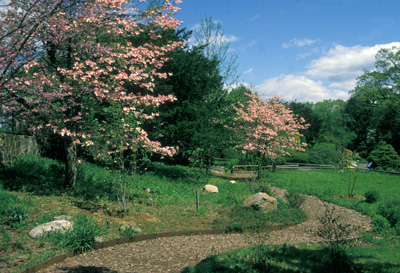 Over my three decades of gardening in the public arena, I’ve seen numerous landscaping trends come and go. However, landscaping with natives has always been popular, with current interest in this genre at an all-time high—and with good reason! A designer with a strong native plant background can meet virtually any design need by using native plants. Further, these days there seems to be something of a clarion call in the green industry to landscape with natives. I’m witnessing private, commercial, and even municipal planting specifications that are mandating, or at least strongly encouraging, using native plants in landscape designs.
Over my three decades of gardening in the public arena, I’ve seen numerous landscaping trends come and go. However, landscaping with natives has always been popular, with current interest in this genre at an all-time high—and with good reason! A designer with a strong native plant background can meet virtually any design need by using native plants. Further, these days there seems to be something of a clarion call in the green industry to landscape with natives. I’m witnessing private, commercial, and even municipal planting specifications that are mandating, or at least strongly encouraging, using native plants in landscape designs.
While this trend is sweeping the country, landscaping with natives is often done without much thought. Typically the designer is just substituting native counterparts of exotic plants using conventional design criteria. As with the increased interest in natives, another “in” industry phenomena is the concept of creating “sustainable” gardens and landscapes. My definition of a sustainable landscape is one where, once the plants are established (typically a one- to two-year process) the need for additional irrigation, fertilization, or pesticides should be nil. Sounds nice, but I have seen very few examples of sustainable landscapes.
Many “sustainable” landscape designers are using the “natural” model, going “wild” by using native plants in a more naturalistic design. While these intentions are laudable, unless one thoroughly analyzes the growing characteristics of the property and makes wise plant selections based on their investigations, their plantings are destined to need continued sustenance. Even if the necessary site investigations are made and plants are selected based upon growing constraints, unless accepted planting and post-planting care guidelines are used, even the best natives for your site will perform poorly.
One popular application associated with landscaping with natives involves restoration projects in woodlands, meadows, wetlands or other riparian areas where the goal is to introduce indigenous native species back into their representative habitats. This approach is also finding some popularity in residential and even commercial landscapes. While it is typically used for large areas that have varying degrees of functioning native plant communities present, it does have a place in “small” landscapes. The time has come for ecologically designed landscape, and there is no reason that even the smallest of landscapes can’t duplicate a particular and appropriate habitat and landscape with plants obligate to that ecological niche.
This approach is not for the faint of heart and does require something of a learning curve. A working knowledge of the natives of your region coupled with an understanding of some important ecological principles is essential in establishing sustainable native plant communities.
Brad Roeller will be teaching three classes March 28 during Native Plants Saturday, an all-day Continuing Education program in the Watson Education Building at The New York Botanical Garden.
Posted in People, Science on March 25 2009, by Plant Talk
During The Orchid Show: Brazilian Modern, Plant Talk takes a look at some of the research and conservation efforts of The New York Botanical scientists whose work is focused in Brazil. This interview was conducted by Jessica Blohm, Interpretive Specialist for Public Education.
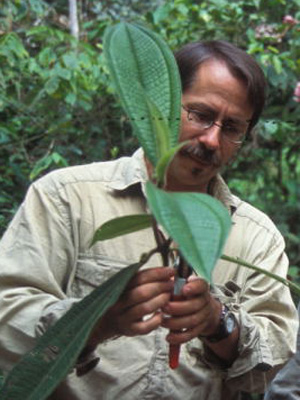 Dr. Doug Daly examines the ant domatia (chambers) of a
Dr. Doug Daly examines the ant domatia (chambers) of a Tococa
(Melastomataceae) in Acre, Brazil. Ants live and reproduce in the swollen leaf petioles, and in return they protect the plant from herbivores. Photo by Rogerio Reis/Black Star“For me, the pure enjoyment of botany is in exploration, discovery, and especially solving puzzles,” says Dr. Douglas Daly, the B.A. Krukoff Curator of Amazonian Botany. A 30-year veteran of the Garden, he focuses on three avenues of research: flora and conservation of the Southwestern Amazon region, applications of plant taxonomy and systematics in ecology and public policy, and systematics of the Burseraceae, a diverse family of tropical trees and shrubs best known as a source of frankincense and myrrh.
Some of the mysteries he unravels help to conserve biodiversity in Brazil. For instance, his new book, Manual of Leaf Architecture, which he co-wrote with six other botanists, provides a detailed framework for describing leaves that is enabling loggers and conservationists to distinguish rare and endangered tree species in the field and the herbarium. At the same time, he has been the catalyst for bringing together the World Wildlife Fund-Brasil, the Forest Stewardship Council, the Tropical Forest Institute, the Brazilian Forest Service, and Amazonian state agencies to work together on overhauling the biodiversity aspects of the standards and procedures for managing certified forest operations as well as operations in national forests in Brazil.
His wide-ranging research in the southwestern Amazon, especially in Acre, Brazil, not only helps regional governments designate conservation areas, but it also produces vital information about useful plants that aids forest dwellers to better manage their resources for a more sustainable living from the forest. The book he published with his colleague Marcos Silveira in 2008, First Catalogue of the Flora of Acre, Brazil, is the first of its kind for any major part of the Brazilian Amazon.
A sample of his publications illustrates the scope of his work:
- The local branch: Toward better management of production forests in Amazonia.
- “Lost” plant collections from the Amazon 1. The 1899 expedition of Dr. Luigi Buscalioni. (w/ A. Miloza)
- Cacao and its relatives in South America: An overview of taxonomy, ecology, biogeography, chemistry, and ethnobotany. (w/ N. Bletter)
- A digital base map for studying the Neotropical flora. (w/ N. Bletter)
- Floristic aspects of the Rio Juruá basin: Botanical history, peculiarities, similarities, and importance for conservation. (w/ M. Silveira)
- Forests of the Rio Negro. (book edited w/ A. Oliveira)
- Lowland vegetation of tropical South America—an overview. (w/ J. Mitchell)
- The “black holes” of diversity—Studies in Acre reveal the precariousness of our knowledge of the Amazonian flora. (w/ M. Silveira)
- The role of the physician in medicinal plant research. (w/ Dr. C. Limbach)
- The National Cancer Institute Plant Collections Program: Update and implications for tropical forests.
“When you work with biodiversity, resource management, and conservation in Brazil, the scale is daunting and the stakes are very high,” says Doug. “But my Brazilian colleagues and the students we are training are so talented, dedicated, and resilient that I really believe we can make a difference in the future of the Amazon region.”
Posted in Wildlife on March 24 2009, by Plant Talk
  |
Wayt Thomas is the Elizabeth G. Britton Curator of Botany in the Institute of Systematic Botany. Stella Sylva is Administrative Curator in the William and Lynda Steere Herbarium. |
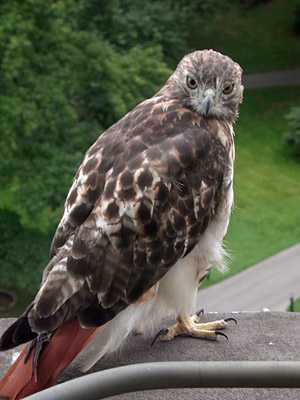
Photo by Tony KirchgessnerFor the past several weeks a pair of red-tailed hawks (Buteo jamaicensis) has been building a nest on the Library building. Their nest is in a small triangular alcove near the top of the front face of the building on the east side (see photos)—they swoop by our office windows on their way to and from the nest.
Last year they started building a nest here but changed their mind and went elsewhere—Fordham University, according to Debbie Becker, who leads the Saturday morning bird walks at the Botanical Garden. This year the hawks seem to be serious. Two weeks ago they were engaged in a very active courtship display and mated several times a day.
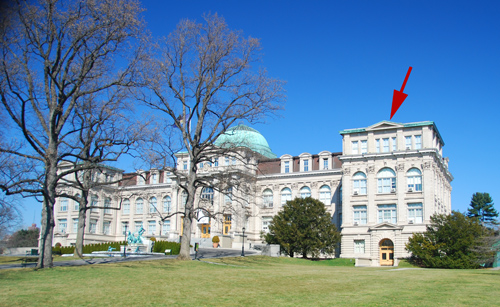
Photo by Wayt ThomasRed-tailed hawk pairs are monogamous, with females (2–4.5 lbs.) larger than males (1.5–3 lbs). The adults have a dark brown back with a pale underbelly and a darker band across the belly; the tail is brick-red above and pinkish below. Our pair is unusual in that they are accompanied by a third hawk—rarely, a second female may help tend the nest and feed the young. This immature bird is an offspring of the pair’s from last year. If everything proceeds according to what we know about these hawks, 1 to 3 eggs will be laid in late March or April—we’ll keep you posted.
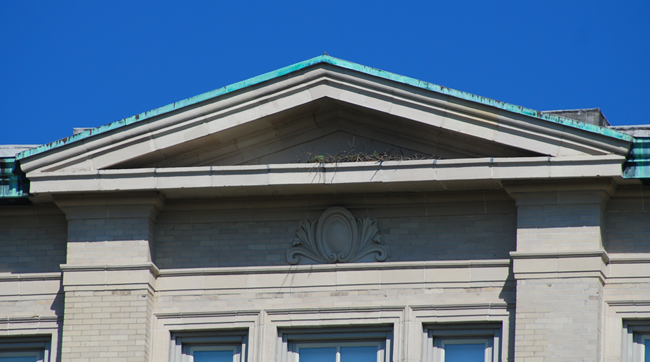
Photo by Wayt ThomasRed-tailed hawks usually feed on small mammals or birds and their preferred habitat is a mix of forest and open areas, such as we have here on the Garden grounds. Their diet consists primarily of squirrels, pigeons, small birds, and rabbits. We don’t know if they are part of the Garden’s Integrated Pest Management plan, but there are fewer squirrels than usual in front of the Library building.
Posted in Programs and Events on March 20 2009, by Plant Talk

Check out all of Saturday’s programming.
Check out all of Sunday’s programming.
Posted in Exhibitions, The Orchid Show on March 19 2009, by Plant Talk
 Gregory Long is President and CEO of The New York Botanical Garden.
Gregory Long is President and CEO of The New York Botanical Garden.
 You owe it to yourself to join the plant, nature, and orchid enthusiasts arriving in record numbers to see the Garden’s absolutely world-class Orchid Show: Brazilian Modern.
You owe it to yourself to join the plant, nature, and orchid enthusiasts arriving in record numbers to see the Garden’s absolutely world-class Orchid Show: Brazilian Modern.
The combination of creative talents Raymond Jungles, the designer, and Fran Coelho, who creates all of our Conservatory exhibitions, is mind boggling. This is something you could see nowhere else in the world—the design and execution are tropical horticulture at its most perfect. Notice in the photograph the huge hanging basket of tropical aroids and descending orchids—there is a matched set of four of these huge hanging baskets created by Fran Coelho. These baskets alone are worth the trip to the Garden, and they are only part of the fun.
Everyone who knows and loves plants must come to see this marvelous masterpiece. The exhibition runs through April 12, and come soon, because I suspect if you see it once, you will want to see it again.
I am usually measured in my praise for NYBG exhibitions, but this orchid show is spectacular—a gift to New York. Come enjoy an exhilarating experience.




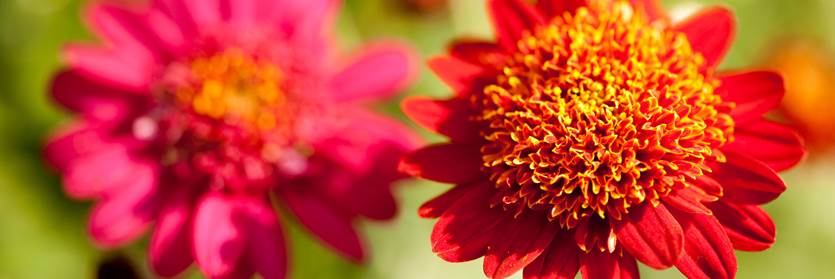

 The displays in The Orchid Show: Brazilian Modern include specimens of orchids and other plants from Brazil that are stored in the Botanical Garden’s William and Lynda Steere Herbarium. The fourth largest herbarium in the world and the largest in the Western Hemisphere, it contains more than 7 million specimens of plants and fungi.
The displays in The Orchid Show: Brazilian Modern include specimens of orchids and other plants from Brazil that are stored in the Botanical Garden’s William and Lynda Steere Herbarium. The fourth largest herbarium in the world and the largest in the Western Hemisphere, it contains more than 7 million specimens of plants and fungi.




 Over my three decades of gardening in the public arena, I’ve seen numerous landscaping trends come and go. However, landscaping with natives has always been popular, with current interest in this genre at an all-time high—and with good reason! A designer with a strong native plant background can meet virtually any design need by using native plants. Further, these days there seems to be something of a clarion call in the green industry to landscape with natives. I’m witnessing private, commercial, and even municipal planting specifications that are mandating, or at least strongly encouraging, using native plants in landscape designs.
Over my three decades of gardening in the public arena, I’ve seen numerous landscaping trends come and go. However, landscaping with natives has always been popular, with current interest in this genre at an all-time high—and with good reason! A designer with a strong native plant background can meet virtually any design need by using native plants. Further, these days there seems to be something of a clarion call in the green industry to landscape with natives. I’m witnessing private, commercial, and even municipal planting specifications that are mandating, or at least strongly encouraging, using native plants in landscape designs. Dr. Doug Daly examines the ant domatia (chambers) of a Tococa (Melastomataceae) in Acre, Brazil. Ants live and reproduce in the swollen leaf petioles, and in return they protect the plant from herbivores. Photo by Rogerio Reis/Black Star
Dr. Doug Daly examines the ant domatia (chambers) of a Tococa (Melastomataceae) in Acre, Brazil. Ants live and reproduce in the swollen leaf petioles, and in return they protect the plant from herbivores. Photo by Rogerio Reis/Black Star






